هل وجدت نفسك في حيرة من أمرك حول مصطلح تقويم الموارد في عالم إدارة المشاريع؟
حسنًا، حان الوقت لإزالة هذا الغموض. 🕵️♀️
في البداية، قد تبدو تقويمات الموارد في البداية مجرد قالب آخر تفضل أن تتجاهله. بعد كل شيء، لديك بالفعل سير عمل فعال بفضل أداة إدارة المشروع المفضلة لديك، أليس كذلك؟
ولكن امنحنا بضع لحظات لنشرح لك لماذا يمكن أن تكون تقويمات الموارد أداة لتغيير قواعد اللعبة في تخطيط مشروعك، وقد تصبح من أشد المعجبين بها. إذا كانت أهدافك تتضمن تحسين الجداول الزمنية للفريق، وضمان كفاءة تخصيص الموارد ، وقيادة فريقك أو مدير مشروعك لتسليم مشاريع من الدرجة الأولى في الوقت المحدد، ستحتاج إلى إبقاء هذه المقالة في متناول يدك.
في هذا الدليل، سوف تكتشف
- ما هو تقويم الموارد؟
- لماذا تحتاج إلى تقويم الموارد في إدارة المشاريع
- متى تستخدم تقويم الموارد
- 6 أشياء يجب تضمينها في تقويم الموارد
- كيفية إنشاء أول تقويم للموارد
لذا، دعنا نتعمق في الأمر.
ما هو تقويم الموارد؟
تقويم الموارد هو أداة تُظهر الموارد المتاحة لمدير المشروع أو قائد الفريق المتاح للعمل بها خلال فترة زمنية محددة. يوضح هذا النوع من تقويم المشروع عدد ساعات العمل المتاحة لأعضاء فريقك ومعداتك في فترة زمنية معينة.
على سبيل المثال، إذا كان العامل يعمل لمدة ثماني ساعات في اليوم ويقضي بالفعل ثلاث ساعات من وقته في المشروع (أ)، فلديك خمس ساعات إضافية من وقته لتعيين مهام مثل المشروع (ب) والمشروع (ج).
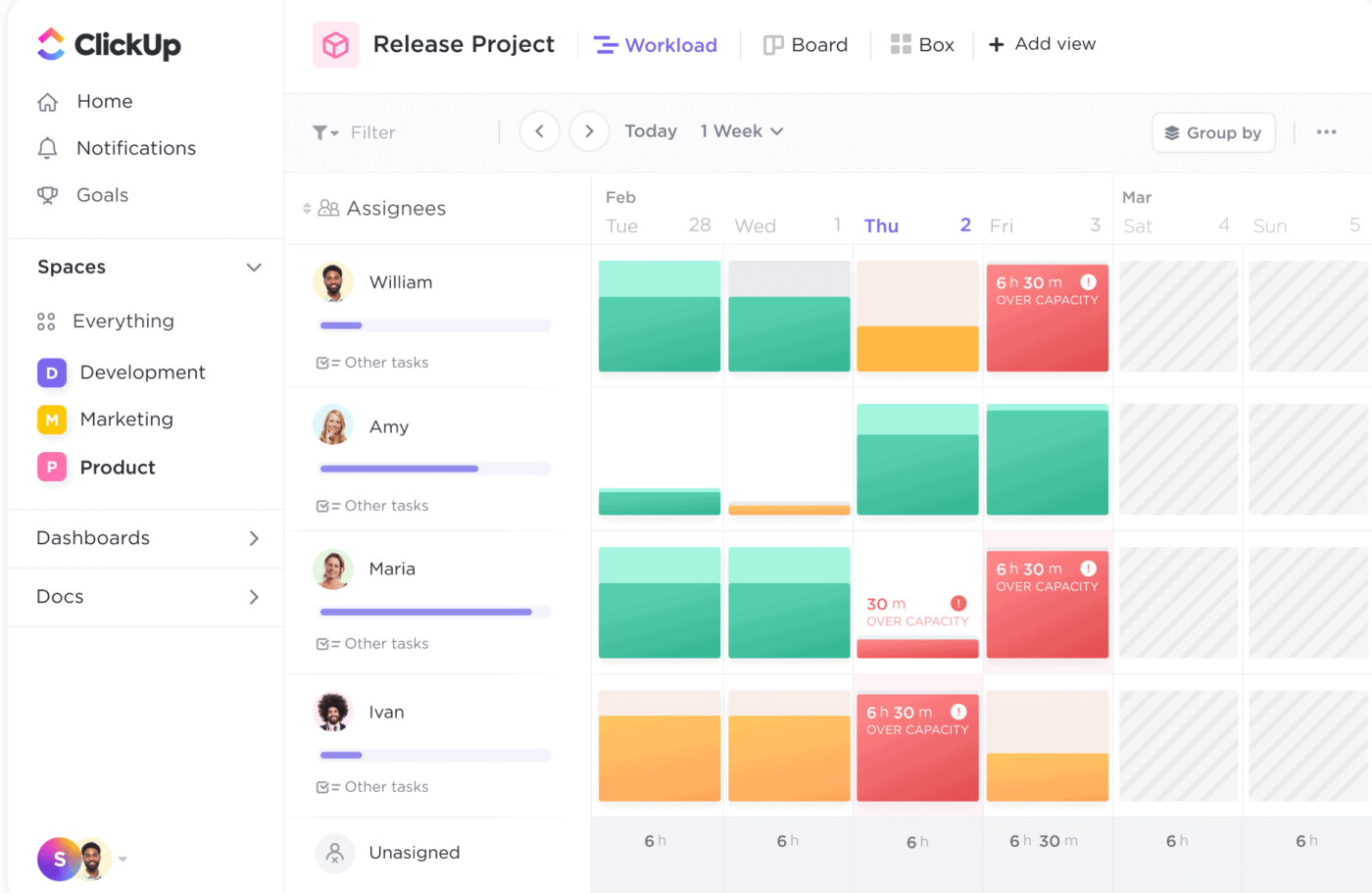
افهم في لمحة سريعة من في فريقك الذي يعاني من نقص أو إفراط في العمل حتى تتمكن من التعامل بسهولة مع إعادة تخصيص الموارد باستخدام طريقة عرض عبء العمل في ClickUp
وبالمثل، تحسب تقويمات الموارد أيضًا عدد الساعات التي يمكن أن تعمل فيها آلاتك. تدوِّن تقويمات المشروع هذه أيضًا تفاصيل أخرى مثل أيام الإجازات، والعطلات الوطنية، وأوقات الراحة، وأسماء المهام، وأسماء أعضاء الفريق والآلات الرئيسية.
في إدارة المشاريع، تحتاج الفرق إلى تقويمات المشاريع لتخصيص الموارد. فهي تساعد على تصور أين يمكن إعادة تخصيص العمل أو تخصيصه - دون التعمق في إدارة الوقت .
ما الفرق بين تقويم الموارد وتقويم المشروع؟
نظرًا لأن كلاً من تقويم الموارد وتقويم المشروع يساعدان في إدارة الأجزاء المهمة من دورة حياة المشروع، فمن الممكن تمامًا الخلط بين الاثنين. لذا، قبل المضي قدمًا، دعنا نتطرق إلى الموضوع بإيجاز لفهم الاختلافات الرئيسية:
- تقويمات الموارد يتم إنشاؤها من قبل مديري الموارد، بينما تقويمات المشاريع يتم إنشاؤها من قبل مديري المشاريع. من المهم ملاحظة أن مديري المشاريع يمكنهم إنشاء تقويمات الموارد أيضًا في حالة عدم وجود مدير
- الأول يحسب الموارد، مثل الأشخاص والآلات والمعدات. من ناحية أخرى، يقوم الأخير بتتبعالجداول الزمنية للمشروع
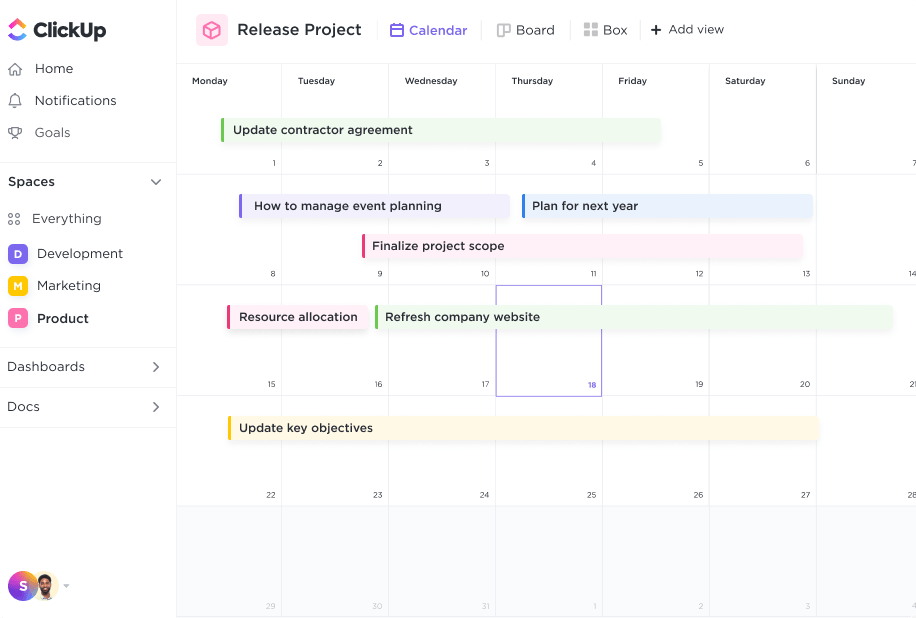
نظّم المشاريع، وخطط الجداول الزمنية، وتصور عمل فريقك على تقويم مرن يبقي الجميع على نفس الصفحة
فوائد تقويمات الموارد لمديري المشاريع
إذا لم يكن لديك فهم دقيق للموارد المتاحة، فقد تبالغ أو تقلل من تقدير عدد المهام التي يمكنك أنت وأعضاء فريقك إنجازها في فترة زمنية محددة.
يمكن أن يوفر تقويم الموارد الخاص بك رؤية مجهرية ومجهرية لمواردك. تسمح لك تقويمات المشاريع والموارد بتحديد مقدار العمل الذي يمكنك القيام به بدقة في جدول زمني محدود.
دعنا نفترض أن الجزء الأول من هذا القسم صحيح (ويعرف أيضًا باسم "ليس لديك فهم لمواردك")، فقد ينتهي بك الأمر
- خلق صراعات بين أعضاء الفريق الداخليين (على سبيل المثال، قد ترغب الموارد البشرية والمبيعات في الوصول إلى أعضاء فريق معينين في نفس الوقت)
- الحفاظ على جدولة عمل أقل مما هو مطلوب
- الموافقة على عمل أكثر مما يمكنك القيام به
لكن عكس ذلك يعني أن مديري المشاريع يستطيعون ذلك
- تحسين الجداول الزمنية للمشروع والحصول على فهم دقيق لـمعالم المشروع
- إدارة العثرات (مثل الإجازات غير المتوقعة أو الخلل في المعدات)
- إنشاء عبء عمل متوازن لكل عضو من أعضاء الفريق في تقويم المشروع
- تحسين جودة العمل لضمان نجاح المشروع
- مساعدة فريق المشروع على الالتزام بـجدول المشروع
- تخصيص الموارد وتعيين المهام بكفاءة في تقويم المشروع
- تقليل الإرهاق بين أعضاء الفريق (أمر بالغ الأهمية لفرق الموارد البشرية)
- ضمان عدم تعرض الآلات للضغط
- تحسين تدفقات العمل عبر تقويم المشروع
ما هي تقويمات الموارد المستخدمة؟
يقترح العديد من الخبراء إنشاء تقويم للموارد في بداية المشروع، من الناحية المثالية خلال مرحلة تخطيط المشروع. ومع ذلك، إذا لم يكن ذلك ممكنًا لمديري المشاريع، أو إذا كنت ممن يخصصون المهام قبل أشهر أو أسابيع، يمكنك إنشاء تقويم موارد شهري أو أسبوعي أيضًا.
دعنا نتخيل أن شركتك تتعامل مع مشاريع متعددة ذات مواعيد نهائية متداخلة؛ لذا فأنت تخطط لإنشاء تقويم للموارد قبل البدء في مشروع جديد لتخصيص الموارد المتاحة بشكل صحيح.
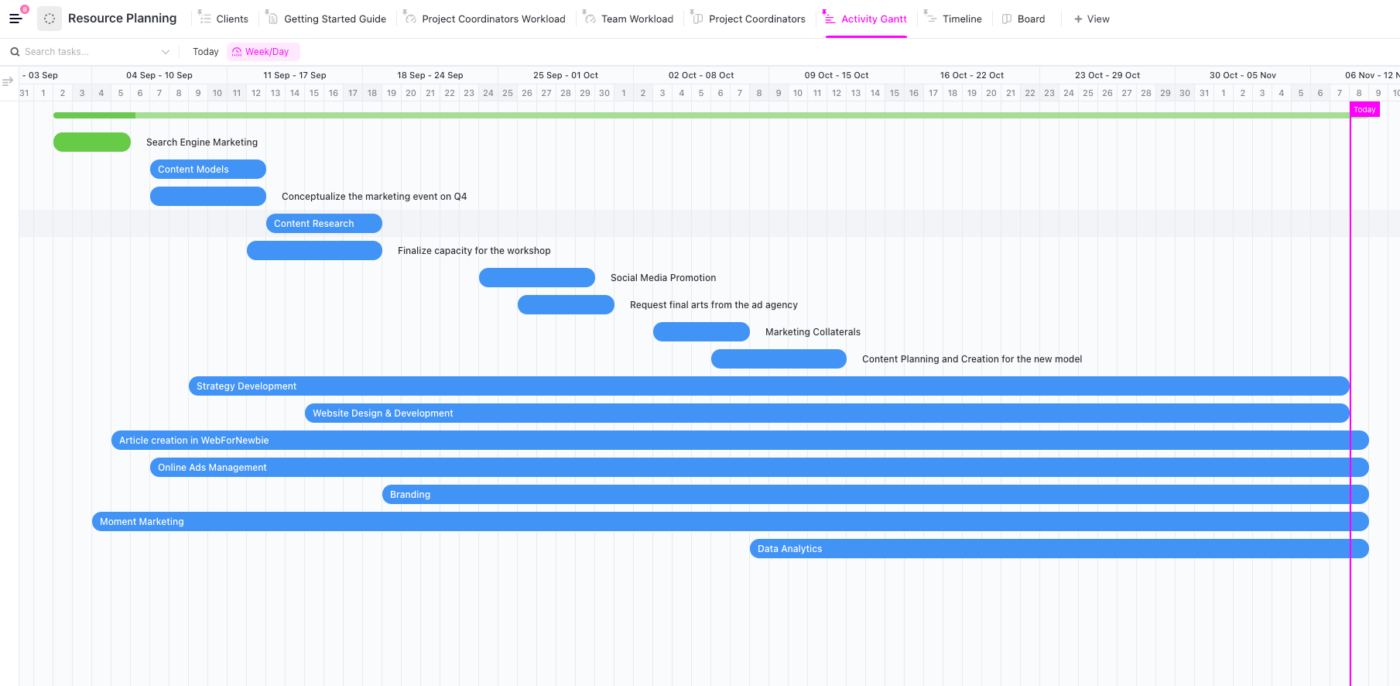
يتطلب تخطيط مواردك تخطيط تقويمات مشروعك لإظهار كل شيء على الطاولة حتى تتمكن من تحديد الاختناقات المحتملة قبل البدء
للقيام بذلك، قد تحتاج إلى التحقق مرة أخرى من الأشخاص الذين يمكن أن يكونوا جزءًا من فريق المشروع الإضافي بناءً على المهارات المطلوبة للمهمة، وتوافر الفريق الحالي، والآلات والبرامج القادرة على تحقيق أهدافك قبل أن تتمكن من بدء المشروع.
في هذه الملاحظة، يجب أن يقوم مدير المشروع بمهام إدارة المشروع الأخرى، مثل إنشاء تقويم للمشروع، وتحليل مراحل المشروع المختلفة، وإنشاء جدول زمني للمشروع، وما إلى ذلك، من الناحية المثالية يجب أن يقوم بها مدير المشروع خلال مرحلة التخطيط أيضًا.
ومع ذلك، في بعض الحالات، يتم أيضًا إنشاء تقويم للموارد قبل بدء المشروع.
على سبيل المثال، إذا تقدمت شركة الإنشاءات بطلب للحصول على قرض عقاري وتنتظر الموافقة عليه، فسيتعين عليها أيضًا تدوين ما يجب القيام به مع الآلات والعمالة والأموال المتاحة حتى يتم منح القرض - وكل هذا لا يمكن القيام به إلا من خلال تقويم الموارد في متناول اليد.
6 ميزات يجب تضمينها في تقويم الموارد
الآن، دعنا الآن ندخل في التفاصيل الدقيقة ونستكشف ما يجب أن يكون في تقويم الموارد - قبل أن نمضي قدمًا ونشارك دليلًا تفصيليًا حول كيفية إنشاء تقويم للموارد وما هو مطلوب فيه.
1. أسماء وأدوار أعضاء الفريق
يجب أن يحتوي كل تقويم للموارد على أسماء وأدوار أعضاء الفريق الرئيسيين. تفضل بعض الشركات المضي قدمًا خطوة واحدة إلى الأمام وتضمين تفاصيل أخرى مثل هاتف عمل عضو الفريق أو عنوان بريده الإلكتروني للحصول على تقويم أكثر كفاءة للمشروع.
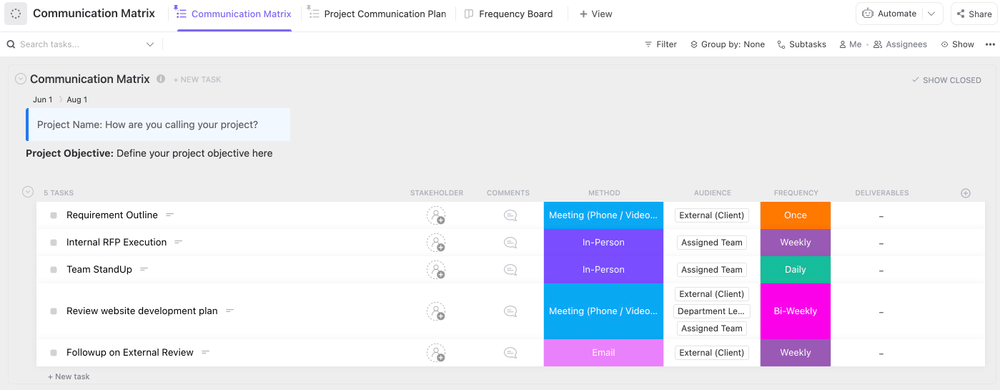
قم بتحسين تواصل الفريق وتوفير بيئة آمنة من خلال نموذجنا، بحيث تدعم أساليب التواصل المختلفة وتوضح أنواع عناصر العمل
ولكن، والحق يقال، يمكنك الاكتفاء بالأساسيات فقط - بما أنك تحتاج إلى أسماء أعضاء الفريق وساعات عملهم لمعرفة مدى توفرهم، فلماذا الاستطراد؟ قم بإنشاء مستند تواصل الفريق أو استخدم قالباً بسيطاً مثل ClickUp قالب مصفوفة اتصالات الفريق والاجتماعات .
أيضًا، عند تدوين أسماء وأدوار الفريق، لا تنسَ إضافة أسماء قادة الفريق إلى القالب. في حالة احتياج مدير الموارد إلى تغيير الجداول الزمنية هنا وهناك، سيعرف قائد الفريق الذي يجب التحدث إليه لأي مهمة في تقويم المشروع.
2. التوفر، بما في ذلك ساعات العمل والمناوبات وأيام الإجازة
هذا هو الجزء الأكثر أهمية في تقويم الموارد الخاص بك - تتبع التوافر، والمناوبات، وأيام الإجازات، والعطلات الوطنية، وما إلى ذلك. يمكنك إما تدوين التوافر اليومي للموظف أو، إذا كنت تنشئ تقويمًا أسبوعيًا، فيمكنك تدوين التوافر الأسبوعي (وهكذا).
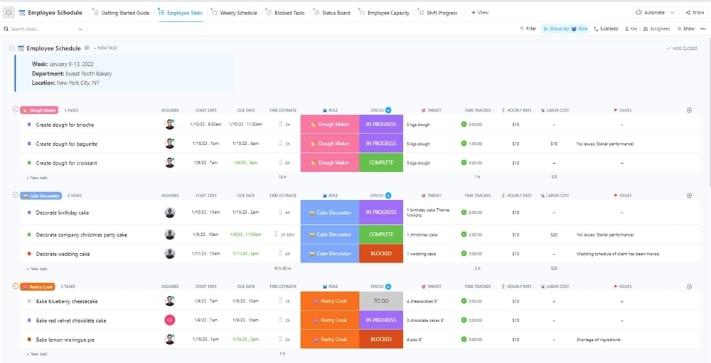
خطط نوبات عمل موظفيك واحسب تكاليف العمالة لديك باستخدام قالب جدول عمل الموظفين ClickUp هذا
على سبيل المثال، مع التوافر اليومي، ستعرف عدد الساعات في اليوم التي يكون فيها عضو الفريق "أ" متفرغاً. وبالمثل، مع التوافر الأسبوعي، ستعرف عدد الأيام في الأسبوع التي يكون فيها عضو الفريق "ب" متفرغاً.
مورد آخر رائع لاستخدامه هنا هو قالب جدول الموظفين ClickUp . يتيح لك ذلك تسجيل ساعات العمل والتوافر لكل عضو رئيسي في الفريق بسهولة لإدارة الموارد بشكل أفضل ومعرفة الحالة العامة للمشروع.
نوصي أيضًا أنه بدلاً من مجرد تتبع وقت كل عضو من أعضاء الفريق على حدة، أنت تنشئ جدولة الموظفين الأحداث التي ستساعدك على حساب وقت الفريق ككل (وهو أمر ضروري لجلسات العصف الذهني ومعالجة ملاحظات العملاء وفهم تفاصيل المشروع والعمل بفعالية).
3. المعدات أو البرامج المطلوبة للمشروع
الموارد مثل المعدات، والبرمجيات المحددة، والمواد الخام، وما إلى ذلك، هي أيضًا جوانب حاسمة في تنفيذ المشروع.
على سبيل المثال، إذا كنت قد توليت مهمة تصنيع الأثاث، ولم يكن لديك ما يكفي من المسامير لبناء الأثاث الذي وعدت به عميلك، فستحتاج إلى حساب ذلك في تقويم الموارد الخاصة بك حتى تتمكن من شرائها قبل بدء المشروع.
ملاحظة جانبية: هناك مهام أخرى تبدو غير منطقية، مثل اختيار عبوات المنتجات، أو كتابة أوصاف المنتجات، أو حتى إنشاء سياسة خصوصية للموقع الإلكتروني، والتي قد تكون مهمة في المخطط الكبير للأشياء عند محاولة إكمال مشروع ما، ولكن عادةً لا يتم احتسابها لأنها لا تتعلق مباشرةً بالمهمة نفسها.
لذا، إليك تنبيه لـ قم بتدوين كل هذه المهام في تقويم الموارد الخاص بك! التفاصيل الصغيرة مهمة، ومن السهل حقًا أن تفلت من بين يديك دون توثيقها بشكل صحيح في تقويم المشروع.
4. القدرة على المهام الجديدة
إذا كنت تستخدم برنامجًا متطورًا (مثل انقر فوق ) لإنشاء تقويم للموارد، يجب أن يتيح لك بشكل مثالي معرفة كم من الوقت والتوافر وأعضاء الفريق والموارد التي لديك لتولي مشاريع جديدة.
إذا كنت لا تزال عالقًا في استخدام القلم والورقة، فاستخدم قدراتك على حل الألغاز للعثور على السعة المثلى للمهام الجديدة. وإذا كنت قد سئمت من هذا النهج، فنحن لا نلومك. و ClickUp هنا للقيام بالأعباء الثقيلة نيابةً عنك.
5. المهارات أو التخصصات
تفضل العديد من الشركات تدوين مهارات أو خبرات أحد أعضاء الفريق بجانب اسمه ودوره مباشرةً، ويرجع ذلك بشكل أساسي إلى أنه عندما يأتي مشروع جديد، يمكنهم مطابقة عضو الفريق مع المهارات المناسبة للمهمة المناسبة.
على سبيل المثال، تخيل أنك وكالة تسويق رقمي، وتحصل على مشروع إعادة تصميم موقع إلكتروني جديد لوسيط عقاري. الآن، قد يكون لديك الكثير من كتاب المحتوى في الفريق لتولي هذه المهمة.
ولكن إذا كنت تعرف الكتاب المتخصصين في أي نوع من المحتوى، فستتمكن من مطابقة الكاتب الذي لديه خبرة في مجال العقارات مع هذا المشروع.
6. تكاليف الموارد
تكاليف الموارد هي معلومة رائعة أخرى يجب إضافتها إلى تقويم الموارد الخاص بك لأنها تتيح لك معرفة كم ستدفع مقابل المشروع بالنظر إلى عدد الموارد التي تم استخدامها.
مع الاحتفاظ بنفس المثال المذكور أعلاه، إذا أدركت أن هناك كاتبان عقاريان في الفريق، أحدهما يتقاضى 40 دولارًا في الساعة والآخر يتقاضى 50 دولارًا في الساعة، فقد تضطر إلى اتخاذ قرار بشأن الكاتب الذي ستضعه في المشروع.
يمكنك أيضًا إضافة المزيد من التفاصيل بعد ذلك. على سبيل المثال، ما هو برنامج معالجة كشوف المرتبات الذي يفضله عضو الفريق، وما هي شروط الدفع الخاصة بهم، وما هي الساعات والمناطق الزمنية التي يعملون فيها، وما إلى ذلك.
كيفية إنشاء تقويم الموارد (باستخدام برنامج تقويم الموارد)
دعنا نبدأ في إنشاء تقويم الموارد الخاص بك!
1. اجمع كل تفاصيل مواردك
لإنشاء تقويم فعّال للموارد، ابدأ بإحصاء جميع الموارد التي لديك. على سبيل المثال، قم بتدوين ما يلي:
- كم عدد الساعات التي يعمل فيها أعضاء فريقك في الشهر مقابل عدد الساعات المتاحة لهم؟
- ما هي الآلات التي تحتاجها لإكمال هذا المشروع مقابل الآلات المتاحة (وكم عدد الأيام/الساعات)؟
- إذا كنت بحاجة إلى أي معدات، فما هي المتطلبات مقابل ما هو متوفر لديك؟
- أي موارد أخرى متاحة مقابل الوقت الذي ستحتاج إليه؟
2. اشترك في ClickUp
التالي اشترك في ClickUp أو برنامج متخصص مشابه يمكن أن يساعدك في تصور عبء العمل الخاص بفريقك. يعد ClickUp خيارًا آمنًا للاختيار لأنه يحتوي على قوالب جاهزة، وموثوق به من قبل آلاف العملاء، كما أنه يحتوي على تدابير أمنية مثل المصادقة متعددة العوامل في مكانه.
إذا لم تكن مرتاحًا بعد لشراء الإصدار المدفوع من ClickUp، يمكنك المضي قدمًا في استخدام الإصدار المجاني أيضًا.
ملاحظة: يمكنك أيضًا استخدام جدول بيانات Excel أو تقويم Google أو جداول بيانات Google للحصول على نظرة عامة عالية المستوى عن عبء العمل على الجميع.
3. استخدم نموذج جدولة وتخطيط الموارد
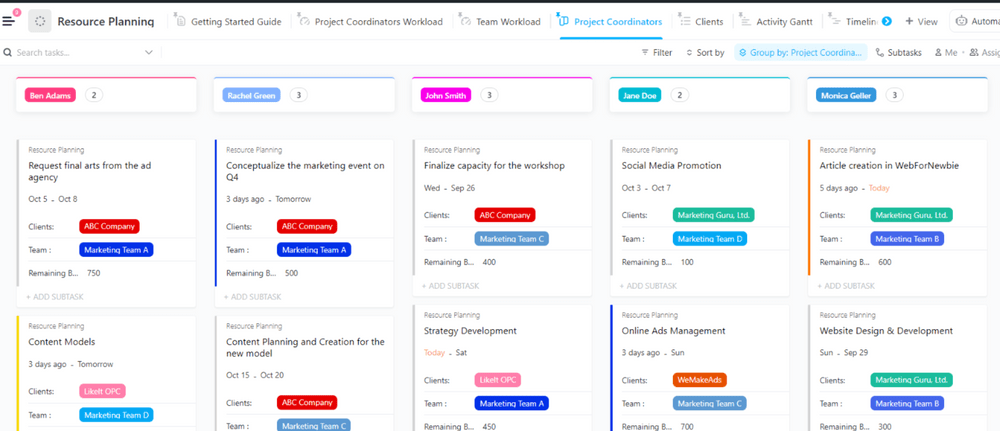
احصل على تمثيل مرئي لمواردك المتاحة في عرض كانبان بالسحب والإفلات البسيط
بمجرد أن تقوم بالتسجيل بنجاح، فإن الخطوة التالية في القائمة ستكون الاستفادة من المجاني قالب تخطيط موارد ClickUp (يمكنك العثور على قوالب مشابهة في مكتبة قوالب ClickUp).
من هنا، إما قم بتصدير بياناتك إذا كنت تعمل بالفعل في ClickUp أو قم بتعبئة الحقول يدويًا.
4. تصور سعة مواردك باستخدام طريقة عرض عبء العمل
تقويم الموارد هو قالب شامل للغاية، لذا ستتمكن من الحصول على صورة دقيقة لسعة مواردك المشتركة بعدة طرق وأشكال.
على سبيل المثال، يمكنك تتبع الموارد من خلال التحقق من عبء العمل لأعضاء الفريق أو الفرق بأكملها أو العملاء، إلخ.
ومن ثم، يمكنك الذهاب إلى أبعد من ذلك من خلال تحليل الموظف الذي يعمل على مشروع العميل في أي مشروع عميل وفي أي وقت، وما هي تواريخ الاستحقاق و التسليمات من هذه المشاريع المعقدة، وما هي الميزانية المخصصة لكل مورد، وما هو الجدول الزمني الذي يجب الالتزام به، ومن هم المنسقون في بيئة المشروع.
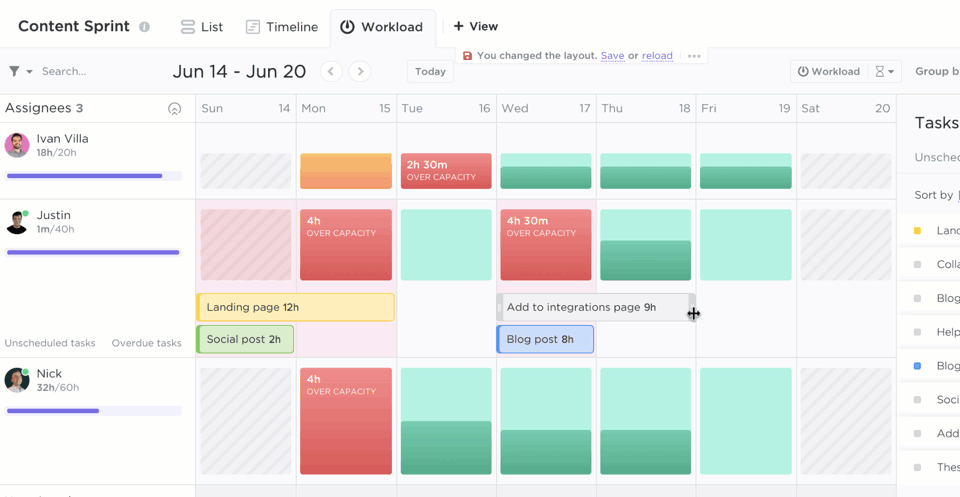 img/
img/
استخدم طريقة عرض عبء العمل في ClickUp لمعرفة من هو متقدم أو متأخر وسحب المهام وإفلاتها بسهولة لإعادة تخصيص الموارد
إذا كنت ترغب في تتبع أعضاء الفريق الفرديين أو أعباء عمل الموارد، انقر على عرض > عرض عبء العمل للحصول على نظرة شاملة .
5. إدارة سعة عبء العمل عبر السحب والإفلات في طريقة عرض الفريق
المهمة الوحيدة المتبقية في قائمتك هي إدارة الموارد بحيث لا تؤثر على سير العمل، وتسريع الوقت اللازم للتسليم، والحفاظ على معنويات الفريق في أعلى مستوياتها على الإطلاق
بعد الحصول على ملخص مرئي للوقت المتاح لكل عضو من أعضاء الفريق، يمكنك بعد ذلك تغيير الجداول الزمنية أو إضافة مهام مختلفة وفقًا لذلك لضمان سير الأمور بسلاسة.
للقيام بذلك، عليك الذهاب إلى "عرض" واختيار "الفريق"

عرض أعباء العمل عبر فريقك لإجراء تعديلات أو تعيين عمل جديد أو تخصيص الموارد لأعضاء الفريق الآخرين
## تقويم الموارد لتسهيل تنفيذ المشروع بسلاسة
دعنا نواجه الأمر. يمكن أن تكون الموارد غير متوقعة. فقد تجد عضوًا حيويًا في الفريق مريضًا لمدة أسبوع. أو قد يحدث عطل في النظام، مما يؤدي إلى توقف العمل بشكل مفاجئ.
في الواقع، قد تبدو مثل هذه السيناريوهات أسوأ كابوس لأي مدير مشروع (وهو محق في ذلك)، لكن قوة تقويم الموارد يمكن أن تحول هذه التحديات بسرعة. تقويمات الموارد تمكننا من رؤية واضحة لتوافر الموارد وتخصيصها، مما يسهل تنفيذ المشروع بسلاسة.
إنها بمثابة منارة، ترشدنا خلال العاصفة وتتيح لنا التحول السريع حتى في مواجهة الشدائد. تساعدنا على تجنب الإفراط في التخصيص، وتساعد في تخصيص المهام بكفاءة، وتساهم في جدولة أكثر واقعية للمشروع.
ما الذي لا يعجبك؟
وتذكر أن تقويم الموارد ليس مجرد مستند ثابت بل أداة ديناميكية تتطور مع مشروعك. لذا، ابدأ في إنشاء تقويم الموارد اليوم. وسرعان ما ستقدّر التحكّم المحسّن والرؤية المحسّنة للموارد المشتركة التي تجلبها لمشاريعك.
 ---
---
الكاتب الضيف:_

٪ / href/ https://www.linkedin.com/in/juwaria-merchant-2595b7153/ %/%/ref// تاجر جويرية %/%href/
_ هي كاتبة مستقلة متخصصة في مجالات البرمجيات كخدمة والتسويق والصحة/العافية. مدعومة بأكثر من 3 سنوات من الخبرة، تساعد العلامات التجارية في بناء محتوى يضيف قيمة لأعمالهم. في أوقات فراغها، يمكنك أن تشاهدها وهي تقرأ كتبها المفضلة أو تدرس أحدث الاتجاهات عبر الإنترنت
